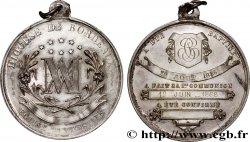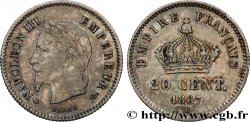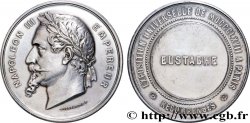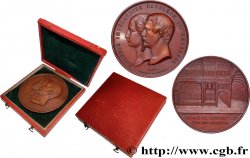fme_928660 - ZWEITES KAISERREICH Médaille, Palais de l’Industrie, Vue des galeries
200.00 €
Menge
In den Warenkorb

Type : Médaille, Palais de l’Industrie, Vue des galeries
Datum: 1855
Name der Münzstätte / Stadt : 75 - Paris
Metall : Kupfer
Durchmesser : 67,5 mm
Stempelstellung : 12 h.
Graveur CAQUÉ Armand Auguste (1795-1881) / GERVAIS ET CIE EDIT.
Gewicht : 166,61 g.
Rand lisse + Main CUIVRE
Punze : main indicatrice (1845-1860) et CUIVRE
Kommentare zum Erhaltungszustand:
Jolie patine marron présentant quelques traces de manipulation
Vorderseite
Titulatur der Vorderseite EUGÉNIE IMPÉRATRICE . NAPOLÉON III EMPEREUR.
Beschreibung Vorderseite Têtes d’Eugénie et de Napoléon III à gauche, signé : CAQUE. F. / GRAVEUR DE S. M. L’EMPEREUR.
Rückseite
Titulatur der Rückseite PALAIS DE L’INDUSTRIE / VUE DES GALERIES.
Beschreibung Rückseite Vue de l’intérieur du palais de l’Industrie, avec les galeries et colonnades. Signé : JACQUES WIENER FEC. et MANGUIN DEL..
Kommentare
Médaille conservée dans un écrin rouge à la fermeture en partie cassée.
Diverses médailles commémorent l’édification de ce Palais de l’Industrie.
Le Palais de l'Industrie et des Beaux-arts, ou plus communément Palais de l'Industrie, est un édifice construit pour l'Exposition universelle de 1855 sur les Champs-Élysées à Paris. Il est l'œuvre de l'architecte Victor Viel et de l'ingénieur Alexis Barrault. Il est détruit à partir de 1896 pour laisser place au Petit Palais et au Grand Palais.
Inauguré le 15 mai 1855 par Louis-Napoléon Bonaparte, récemment devenu l'empereur Napoléon III, il fut l'emblème de la première Exposition universelle française. Cette Exposition, qui attira plus de cinq millions de visiteurs, fut la réponse du chef de l'État français au succès de l'Exposition universelle de 1851 de Londres, célébrée notamment pour l'audace et la nouveauté de son Crystal Palace.
Medal preserved in a red case with a partially broken clasp. Various medals commemorate the construction of this Palace of Industry. The Palace of Industry and Fine Arts, or more commonly the Palace of Industry, is a building constructed for the 1855 Universal Exhibition on the Champs-Élysées in Paris. It is the work of the architect Victor Viel and the engineer Alexis Barrault. It was demolished in 1896 to make way for the Petit Palais and the Grand Palais. Inaugurated on May 15, 1855, by Louis-Napoléon Bonaparte, who had recently become Emperor Napoleon III, it was the emblem of the first French Universal Exhibition. This Exhibition, which attracted more than five million visitors, was the response of the French head of state to the success of the 1851 Universal Exhibition in London, celebrated in particular for the audacity and novelty of its Crystal Palace.
Diverses médailles commémorent l’édification de ce Palais de l’Industrie.
Le Palais de l'Industrie et des Beaux-arts, ou plus communément Palais de l'Industrie, est un édifice construit pour l'Exposition universelle de 1855 sur les Champs-Élysées à Paris. Il est l'œuvre de l'architecte Victor Viel et de l'ingénieur Alexis Barrault. Il est détruit à partir de 1896 pour laisser place au Petit Palais et au Grand Palais.
Inauguré le 15 mai 1855 par Louis-Napoléon Bonaparte, récemment devenu l'empereur Napoléon III, il fut l'emblème de la première Exposition universelle française. Cette Exposition, qui attira plus de cinq millions de visiteurs, fut la réponse du chef de l'État français au succès de l'Exposition universelle de 1851 de Londres, célébrée notamment pour l'audace et la nouveauté de son Crystal Palace.
Medal preserved in a red case with a partially broken clasp. Various medals commemorate the construction of this Palace of Industry. The Palace of Industry and Fine Arts, or more commonly the Palace of Industry, is a building constructed for the 1855 Universal Exhibition on the Champs-Élysées in Paris. It is the work of the architect Victor Viel and the engineer Alexis Barrault. It was demolished in 1896 to make way for the Petit Palais and the Grand Palais. Inaugurated on May 15, 1855, by Louis-Napoléon Bonaparte, who had recently become Emperor Napoleon III, it was the emblem of the first French Universal Exhibition. This Exhibition, which attracted more than five million visitors, was the response of the French head of state to the success of the 1851 Universal Exhibition in London, celebrated in particular for the audacity and novelty of its Crystal Palace.








 Berichten über einen Fehler
Berichten über einen Fehler Die Seite drucken
Die Seite drucken Teilen meiner Auswahl
Teilen meiner Auswahl Stellen Sie eine Frage
Stellen Sie eine Frage Einlieferung/Verkauf
Einlieferung/Verkauf
 Details
Details










